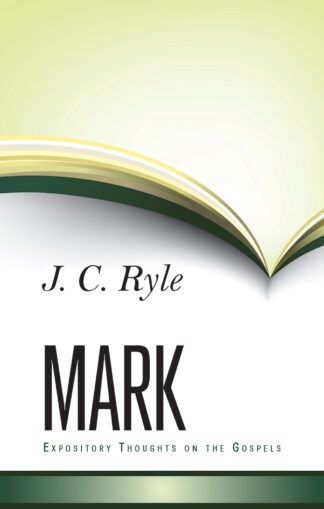A Few Characteristics of the Gospel of Mark
According to tradition this Gospel was composed to satisfy the urgent request of the people of Rome for a written summary of Peter’s preaching in that city. However, this cannot mean that the information found in this book must be withheld from everybody living outside of the city limits of the capital. As is clear from 1:37; 10:45; 12:9; 13:10; and even 16:15 (whatever be its authenticity), this Gospel was intended to reach the entire Greek speaking world: its message was, is, and is going to be meaningful for everybody.
That it was composed for a non-Jewish public would seem to follow from the fact that such Semitic terms and expressions as boanerges (3:17), talitha cumi (5:41), corban (7:11), ephphatha (7:34), and Abba (14:36) are by Mark translated into Greek. Moreover, the author explains Jewish customs (7:3, 4; 14:12; 15:42). And as to this Gospel’s origin in Rome note that at times Mark renders Greek into Latin. He mentions that the two lepta (‘copper coins’) which the poor widow cast into the offering box amounted to one Roman quadrans (‘penny’, 12:42), and that the aule (‘palace’) into which the soldiers led Jesus was the praetorium (the governor’s official residence, 15:16).
Mark is also the only Gospel that informs us (15:21) that Simon of Cyrene was ‘the father of Alexander and Rufus’, who were evidently well-known in Rome (see Rom 16:13).
To all this should be added the fact that the manner in which Mark pictures the Christ, namely, as an active, energetic, swiftly moving, warring, conquering King, a Victor over the destructive forces of nature, over disease, demons, and even death, would be of interest especially to Romans — people who, in their lust for and exercise of power, had conquered the world. To them Mark pictures a King who excels any earthly conqueror. His kingdom is far more extensive, his armour far more effective, and his rule far more enduring than anything originating here below. His victories, moreover, are far more honourable, for he causes the conquered to share in the glory of the conquest. Mark’s King is the Saviour-King. He is the Victor who does not gloat over the suffering of the conquered but suffers in their place and with a view to their everlasting welfare (10:45). . .
A closely related question is: In writing this Gospel did Mark intend merely to supply information or also to bring about transformation? Was it his purpose, as some maintain, merely to record a narrative, or in so doing to furnish an incentive for living to the glory of God? To phrase it differently, how did he view Jesus? Merely as a very interesting personage, the story of whose mighty deeds must be related because it is fascinating and satisfies people’s curiosity? Or did he primarily regard Jesus to be the mighty and conquering Saviour King, to whom all men should turn in humble faith? Surely the latter! It must ever be borne in mind that Mark was ‘Peter’s interpreter.’ Now whenever Peter preached he urged repentance. His predication amounted to, at least reached a climax of, exhortation (Acts 2:36-40; 10:43), in order that through repentance and faith men might be saved, to God’s glory (Acts 11:18). Now if that was true with respect to Peter, it must also have been true with respect to Mark. Mark’s Gospel, accordingly, does have a definitely doctrinal and thoroughly practical aim. It is a narrative, to be sure, but a narrative with a most noble purpose (Mark 10:45; 12:28-34; 16:16).
Now a person’s willingness to surrender himself to Jesus depends upon how he views him; in other words, faith always implies doctrine. Even narrative is not without its doctrinal implications. The Christology implied throughout in Mark’s Gospel is that, to begin with, Jesus is thoroughly human. He eats (2:16) and drinks (15:36). He becomes hungry (11:12). He touches people (1:41) and is touched by them (5:27). He becomes grieved (3:5) and indignant (10:14). He falls asleep from fatigue and is awakened (4:38, 39). He asks that a boat be provided for him, so that he may not be crushed (3:9). He (for a while) plies a trade; he has a mother, brothers and sisters (6:3). Viewed as a man, his knowledge is limited (13:32), so that he turns around to see who has touched him (5:30), and walks up to a fig tree to see whether it has edible fruit (11:13). He has a human body (15:43) and a human spirit (2:8). He even dies (15:37)!
However, this same Jesus of Mark’s Gospel is also thoroughly divine.
The ‘Son of man’ (2:10, 28; etc.) is also ‘Son of God’ (1:1; 3:11; etc.). The One whom Mark describes reigns supreme in the realm of disease, demons, and death. As such he heals diseases of every variety, casts out demons (1:32-34), cures the blind, the deaf, etc. (8:22-26; 1:46-52), cleanses the leper (1:40-45), and even raises the dead (5:21-24, 35-43). He exercises power over the domain of nature in general; for he stills winds and waves (4:35-41), walks on water (6:48), causes a fig tree to wither (11:13, 14, 20), and multiplies a few rolls so that they suffice to satisfy the hunger of thousands (6:30-44; 8:1-10). His knowledge of the future is so detailed and comprehensive that he predicts what will happen to Jerusalem, to the world, to his disciples (chapter 13), and to himself (8:31; 9:9, 21; 10:32-34; 14:17-21). He knows what is in men’s hearts (2:8; 12:15), and knows their circumstances (12:44). His authority is so outstanding that he pronounces pardon in a manner befitting God and no one else (2:1-12, especially verses 5 and 6). The climax of his majesty is revealed in this that when he is put to death he rises again (16:6)!
As to whether Mark pictures this Jesus as the object of faith, this question, too, must be answered with a vigorous affirmative, really already implied in the foregoing. ‘Jesus Christ, the Son of God’, is immediately introduced as the Lord whose coming, in accordance with prophecy, demands a herald or way-preparer (1:1-3). He is the One to whom the angels minister (1:13). His blood is a ransom for many (10:45; cf. 14:24). He baptizes with the Holy Spirit (1:8), is Lord even of the sabbath (2:28), appoints his own ambassadors (3:13-19), has a right to be accepted in faith even by those of ‘his own country’ (implied in 6:6), has authority to bid men follow and receive him (8:34; 9:37), is the very One whom David called ‘Lord’ (implied in 12:37), and is coming again in the glory of his Father (8:38), in clouds with power and great glory, when he will send forth the angels to gather his elect (13:26, 27).
According to this evangelist the two natures, human and divine (to use later terminology), are in perfect harmony. This is a fact which, in studying certain passages, one can hardly fail to detect (4:38, 39; 6:34, 41-43; 8:1-10; 14:32-41; etc.).
Mark’s aim is that men everywhere may accept this Jesus Christ, ‘Son of man’ and ‘Son of God’, this conquering King, as their Saviour and Lord.
The three most obvious characteristics of Mark’s Gospel are compactness, vividness, and orderliness. By compactness is meant that this Gospel is much shorter than any of the others. In the Bible lying before me Luke covers approximately 40 pages, Matthew 37, John 29, and Mark only 23. Luke has about 1147 verses, Matthew 1068. Mark (1:1-16:8) has only 661. Mark contains only one parable not found elsewhere, that of The Seed Growing in Secret (4:26-29). In addition it shares three parables with Matthew and Luke: The Sower (Mark 4:3-9, 18-23), The Mustard Seed (4:30-32), and The Wicked Tenants (12:1-9). Compare this with Matthew’s ten parables that are peculiar to that Gospel, six that it shares with Luke, and three along with Mark and Luke; hence, nineteen parables in all. Luke has eighteen parables all its own. This number added to the nine already implied makes no less than twenty-seven parables for Luke. Since some of the parables are rather lengthy this means that, other things being equal, Mark by omitting so many of them would be considerably shorter than the other Gospels.
What is just as important in this connection is that of the six great discourses found in Matthew only one — the sixth, on The Last Things (Matt 24 and 25; cf. Mark 13) — is found also in Mark, and even then in shorter form. Of the other discourses only remnants, frequently scattered, are reported in Mark. See, however, also Mark 4.
All this means that Mark’s brevity relates especially to the words of Jesus. Nevertheless, the number of verses in Mark that contain such words (some verses have only one or two of them) is not small: 278. They occur especially in chapters 2, 4, 7, 9, 10, and 12. Luke has 588 verses containing dominical words, Matthew 640. Accordingly, while such words are found in approximately 60% of Matthew’s 1068 verses, and in about 51 % of Luke’s 1147, they occur in only about 42% of Mark’s 661. Mark is definitely the action Gospel. It is understandable that because of the omission of so much sayings material there was room even in this short Gospel for a series of miracle stories almost as long as in the much larger Matthew. Each of Mark’s first eleven chapters contains at least one miracle account. Those recorded in 7:31-37; 8:22-26 are peculiar to Mark. Moreover in several cases Mark’s coverage is more detailed and graphic than is that of the other Synoptics.
This leads to the second characteristic of this Gospel, namely, its vividness. Mark’s style sparkles. Was he not the interpreter of vivacious, highly emotional, colourful Simon Peter?
Having therefore studied the Gospel according to Matthew, one cannot afford to skip Mark, thinking, ‘This book contains hardly anything that has not already been said by the publican turned author.’ To be sure, of wholly new material material not paralleled at all either in Matthew or in Luke — there is very little. Only 31 Markan verses are generally mentioned in this connection (1:1; 2:27; 3:20, 21; 4:26-29; 7:3, 4; 7:32-37; 8:22-26; 9:29; 9:48, 49; 13:33-37; 14:51, 52). On the other hand, it is also true that in ever so many passages or paragraphs Mark presents lively little touches that are not found elsewhere. These touches (in addition to the ones already included in the immediately preceding list: 1:1, etc.) enliven the account. The following are examples:
In the wilderness where he was tempted Jesus was ‘among the wild beasts’ (1:13). John the Baptist’s preaching was not exclusively negative: he did not merely tell his audience to repent. He added ‘and believe the gospel’ (1:15). When the fishermen James and John in order to follow Jesus left their father in the boat, they did not overburden him: they left him ‘with the hired men’ (1:20). In healing Simon’s mother-in-law Jesus not merely touched her; tenderly he ‘took her by the hand’ (1:31). That evening at sundown ‘the whole town was gathered at the door’ of Peter’s house (1:33). ‘Very early the next morning Jesus . . . went to a lonely place, and there he prayed.’ It was here that Peter and his companions found him, telling him that everybody was looking for him (1:35-57). The house where Jesus was proclaiming the message was filled to overflowing, in fact, ‘not even near the doorway’ was there any room left (2:2).
At another occasion when Christ’s enemies on a sabbath and in the synagogue were watching him with critical eyes to see whether on this day he would heal a man with a withered hand, Jesus ‘looked around at them with anger, being deeply disturbed by the hardness of their hearts’ (3:5).
It was ‘evening’ when the disciples took Jesus with them in the boat ‘just as he was’ (4:35, 36). Soon he was ‘in the stern asleep on the cushion’ (4:38). To the sea he said, ‘Hush! Be still’ (4:39). He asked his disciples, ‘Even now do you not have faith?’ (4:40).
The story of the healing of the Gerasene demoniac is told with far more detail in Mark than in either Matthew or Luke. Mark devotes twenty verses to it (5:1-20); Luke fourteen (8:26-39); Matthew seven (8:28-34). For example, Mark relates that no one could keep this man in chains or subdue him. He adds, ‘And always, night and day, among the tombs and on the hillsides he was screaming and cutting himself with stones.’ All three Synoptics report that when Jesus gave the demons leave they came out of the man and went into the pigs, which thus possessed rushed down the cliff and into the sea. Mark adds that there were ‘about two thousand’ pigs that drowned. What is true with respect to the cure of the demoniac holds also in the case of the woman who touched Christ’s garment: the full story is told not in Matthew (three verses, 9:20-22), nor in Luke (six verses, 8:43-48), but in Mark (ten verses, 5:25-34). Notice particularly what Mark says — but ‘Dr’ Luke does not say — about physicians! (cf. Mark 5:25 with Luke 8:43). Other details reported exclusively by Mark are found in 5:29b, 30. But though Mark was ‘Peter’s interpreter’ it is not Mark but Luke who brings Peter into the story (8:45) . . .
This article is an extract from Hendriksen’s New Testament Commentary. It was first published in the May 1976 edition of the Banner of Truth magazine.
More on Mark

Description
According to tradition this Gospel was composed to satisfy the urgent request of the people of Rome for a written summary of Peter’s preaching in that city. However, this cannot mean that the information found in this book must be withheld from everybody living outside of the city limits of the capital. As is clear […]

Expository Thoughts on the Gospels
Volume 2: Mark
Description
According to tradition this Gospel was composed to satisfy the urgent request of the people of Rome for a written summary of Peter’s preaching in that city. However, this cannot mean that the information found in this book must be withheld from everybody living outside of the city limits of the capital. As is clear […]
Latest Articles
Finished!: A Message for Easter March 28, 2024
Think about someone being selected and sent to do an especially difficult job. Some major crisis has arisen, or some massive problem needs to be tackled, and it requires the knowledge, the experience, the skill-set, the leadership that they so remarkably possess. It was like that with Jesus. Entrusted to him by God the Father […]
Every Christian a Publisher! February 27, 2024
The following article appeared in Issue 291 of the Banner Magazine, dated December 1987. ‘The Lord gave the word; great was the company of those that published it’ (Psalm 68.11) THE NEED FOR TRUTH I would like to speak to you today about the importance of the use of literature in the church, for evangelism, […]
